Related Research Articles
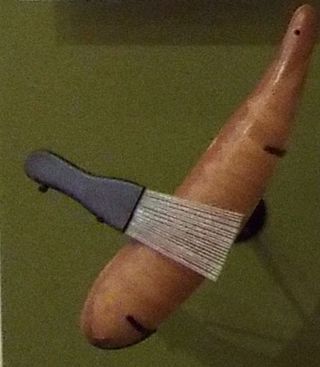
The güiro is a percussion instrument consisting of an open-ended, hollow gourd with parallel notches cut in one side. It is played by rubbing a stick or tines along the notches to produce a ratchet sound.

An idiophone is any musical instrument that creates sound primarily by the vibration of the instrument itself, without the use of air flow, strings (chordophones), membranes (membranophones) or electricity (electrophones). It is the first of the four main divisions in the original Hornbostel–Sachs system of musical instrument classification. The early classification of Victor-Charles Mahillon called this group of instruments autophones. The most common are struck idiophones, or concussion idiophones, which are made to vibrate by being struck, either directly with a stick or hand or indirectly, with scraping or shaking motions. Various types of bells fall into both categories. A common plucked idiophone is the Jew's harp.
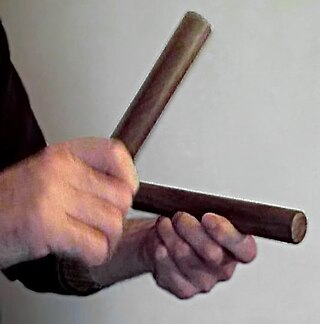
The clave is a rhythmic pattern used as a tool for temporal organization in Cuban music. In Spanish, clave literally means key, clef, code, or keystone. It is present in a variety of genres such as Abakuá music, rumba, conga, son, mambo, salsa, songo, timba and Afro-Cuban jazz. The five-stroke clave pattern represents the structural core of many Cuban rhythms.

Timbales or pailas are shallow single-headed drums with metal casing. They are shallower than single-headed tom-toms and usually tuned much higher, especially for their size. They were developed as an alternative to classical timpani in Cuba in the early 20th century and later spread across Latin America and the United States.

The conga, also known as tumbadora, is a tall, narrow, single-headed drum from Cuba. Congas are staved like barrels and classified into three types: quinto, tres dos or tres golpes (middle), and tumba or salidor (lowest). Congas were originally used in Afro-Cuban music genres such as conga and rumba, where each drummer would play a single drum. Following numerous innovations in conga drumming and construction during the mid-20th century, as well as its internationalization, it became increasingly common for drummers to play two or three drums. Congas have become a popular instrument in many forms of Latin music such as son, descarga, Afro-Cuban jazz, salsa, songo, merengue and Latin rock.
Son cubano is a genre of music and dance that originated in the highlands of eastern Cuba during the late 19th century. It is a syncretic genre that blends elements of Spanish and African origin. Among its fundamental Hispanic components are the vocal style, lyrical metre and the primacy of the tres, derived from the Spanish guitar. On the other hand, its characteristic clave rhythm, call and response structure and percussion section are all rooted in traditions of Bantu origin.
Los Muñequitos de Matanzas is a Cuban rumba ensemble from the city of Matanzas. The group was established in 1952 as Conjunto Guaguancó Matancero and released their first LP in 1956 through Puchito. Since then, Los Muñequitos have continued to perform and record, becoming one of the most successful and critically acclaimed rumba groups of all time.
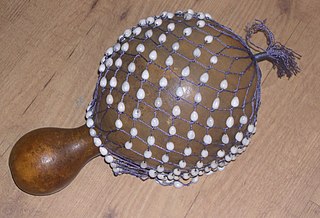
The shekere is a Yoruba percussion instrument consisting of a dried gourd with beads or cowries woven into a net covering the gourd. The Shekere originated in Yorubaland, which comprises the countries of Nigeria, Benin, and Togo. Yoruba. The instrument is common in West African and Latin American folkloric traditions as well as some of the popular music styles. In performance it is shaken and/or hit against the hands.
Afro-Caribbean music is a broad term for music styles originating in the Caribbean from the African diaspora. These types of music usually have West African/Central African influence because of the presence and history of African people and their descendants living in the Caribbean, as a result of the trans-Atlantic slave trade. These distinctive musical art forms came about from the cultural mingling of African, Indigenous, and European inhabitants. Characteristically, Afro-Caribbean music incorporates components, instruments and influences from a variety of African cultures, as well as Indigenous and European cultures.
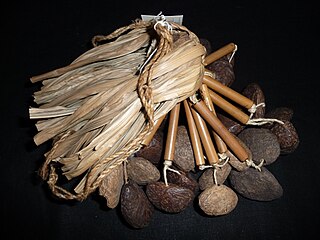
A rattle is a type of percussion instrument which produces a sound when shaken. Rattles are described in the Hornbostel–Sachs system as Shaken Idiophones or Rattles (112.1).

Abakuá, also sometimes known as Ñañiguismo, is an Afro-Cuban men's initiatory fraternity or secret society, which originated from fraternal associations in the Cross River region of southeastern Nigeria and southwestern Cameroon.
Latin percussion is a family of percussion, membranophone, lamellophone and idiophone instruments used in Latin music.
Changuito is a Cuban percussionist.
Cuban Overture is a symphonic overture or tone poem for orchestra composed by American composer George Gershwin. Originally titled Rumba, it was a result of a two-week holiday which Gershwin took in Havana, Cuba in February 1932. Gershwin composed the piece in July and August 1932.

The güira is a percussion instrument from the Dominican Republic used as a percussion instrument in merengue, bachata, and to a lesser extent, other genres such as cumbia. It is made of a metal sheet and played with a stiff brush, thus being similar to the Haitian graj and the Cuban guayo and güiro. Güira, guayo and güiro all have a function akin to that of the indigenous native maracas or the trap-kit's hi-hat, namely providing a complementary beat.
Rumba is a secular genre of Cuban music involving dance, percussion, and song. It originated in the northern regions of Cuba, mainly in urban Havana and Matanzas, during the late 19th century. It is based on African music and dance traditions, namely Abakuá and yuka, as well as the Spanish-based coros de clave. According to Argeliers León, rumba is one of the major "genre complexes" of Cuban music, and the term rumba complex is now commonly used by musicologists. This complex encompasses the three traditional forms of rumba, as well as their contemporary derivatives and other minor styles.

An egg shaker or ganzá is a hand percussion instrument, in the idiophone category, that makes a noise when shaken. Functionally it is similar to a maraca. Typically the outer casing or container is ovoidal or egg-shaped. It is partially full of small, loose objects, such as seeds or beads, which create the percussive sounds as they collide, both with each other and with the inside surface of the container. The egg shaker is a Latin American instrument, cheap to buy and relatively simple to play.
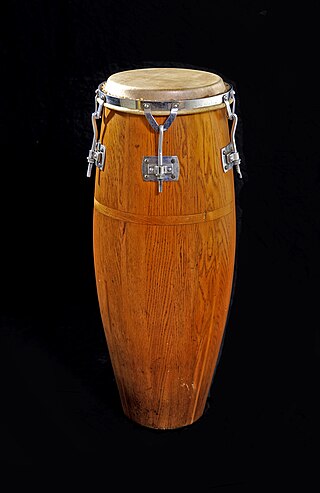
The quinto is the smallest and highest pitched type of conga drum. It is used as the lead drum in Cuban rumba styles such as guaguancó, yambú, columbia and guarapachangueo, and it is also present in congas de comparsa. Quinto phrases are played in both triple-pulse and duple-pulse structures. In columbia, triple pulse is the primary structure and duple pulse is secondary. In yambú and guaguancó duple-pulse is primary and triple-pulse is secondary.
Twoubadou music is a popular genre of guitar-based music from Haiti that has a long and important place in Haitian culture. The word comes from troubadour, a medieval poet-musician who wrote and sang songs about courtly love. Like the troubadours of old, the Haitian twoubadou is a singer-composer who accompanies himself on songs that tell about the bitterness and humor of love, often using risqué or suggestive lyrics.
Tahona, alternatively spelled tajona due to its pronunciation or taona, is a secular style of Afro-Cuban music developed in the 19th century in Santiago de Cuba after the arrival of Haitian slaves following the Haitian Revolution. It is named after the ensembles and the drums played by them. It is considered one of the oldest styles within the rumba complex, and its performance became rare by the 20th century.
References
- ↑ Vásquez, Edwin Ricardo Pitre, and Jan Fairley. "Part III Musical Instruments: 12. Percussion Instruments: Maracas." Continuum Encyclopedia Of Popular Music Of The World 2.(2003): 380-383. Academic Search Complete. Web. 24 Sept. 2013.
- ↑ Archived 2013-09-28 at the Wayback Machine , "Drums and Instrument Percussion". Web. <http://www.iam10son.com/drummers-site-rhythm-and-style/erikundi Archived 2013-09-28 at the Wayback Machine > Retrieved 16 September 2013.
- ↑ "Rumba Instruments: Erikundi". Rumba Instruments. Retrieved 16 September 2013.